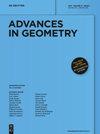L-限制各向同性和相关椭球下的平均表面和体积粒子张量
IF 0.5
4区 数学
Q3 MATHEMATICS
引用次数: 1
摘要
摘要凸几何Minkowski张量包含关于下凸体的形状和方向的信息。因此,它们为具有凸体族中标记的平稳标记点过程,或者,稍微专业一点的,为平稳粒子过程,提供了有价值的汇总统计。我们在这里证明,如果典型粒子的分布在围绕固定k平面的旋转下是不变的,那么典型粒子的平均体积张量可以从k+1维截面导出。这一发现将众所周知的三维特例扩展到了更高的维度。还证明了表面张量的相应结果。在本文的最后一部分,我们展示了如何使用Minkowski张量来定义三个椭球集值汇总统计量,讨论了它们的估计,并举例说明了它们的构造和在仿真中的使用。其中两个,即所谓的Miles椭球和惯性椭球,是基于秩高达2的平均体积张量。第三个,基于秩为2的平均表面张量,将被称为Blaschke椭球,并且只有当典型粒子具有关于轴的旋转对称分布时才被定义,因为我们可以使用来自其秩为2表面张量的旋转中心椭球的唯一性和重建结果。后者也建立在这里。本文章由计算机程序翻译,如有差异,请以英文原文为准。
Mean surface and volume particle tensors under L-restricted isotropy and associated ellipsoids
Abstract The convex-geometric Minkowski tensors contain information about shape and orientation of the underlying convex body. They therefore yield valuable summary statistics for stationary marked point processes with marks in the family of convex bodies, or, slightly more specialised, for stationary particle processes. We show here that if the distribution of the typical particle is invariant under rotations about a fixed k-plane, then the average volume tensors of the typical particle can be derived from k + 1-dimensional sections. This finding extends the well-known three-dimensional special case to higher dimensions. A corresponding result for the surface tensors is also proven. In the last part of the paper we show how Minkowski tensors can be used to define three ellipsoidal set-valued summary statistics, discuss their estimation and illustrate their construction and use in a simulation example. Two of these, the so-called Miles ellipsoid and the inertia ellipsoid, are based on mean volume tensors of ranks up to 2. The third, based on the mean surface tensor of rank 2, will be called the Blaschke ellipsoid and is only defined when the typical particle has a rotationally symmetric distribution about an axis, as we then can use uniqueness and reconstruction results for centred ellipsoids of revolution from their rank-2 surface tensor. The latter are also established here.
求助全文
通过发布文献求助,成功后即可免费获取论文全文。
去求助
来源期刊

Advances in Geometry
数学-数学
CiteScore
1.00
自引率
0.00%
发文量
31
审稿时长
>12 weeks
期刊介绍:
Advances in Geometry is a mathematical journal for the publication of original research articles of excellent quality in the area of geometry. Geometry is a field of long standing-tradition and eminent importance. The study of space and spatial patterns is a major mathematical activity; geometric ideas and geometric language permeate all of mathematics.
 求助内容:
求助内容: 应助结果提醒方式:
应助结果提醒方式:


